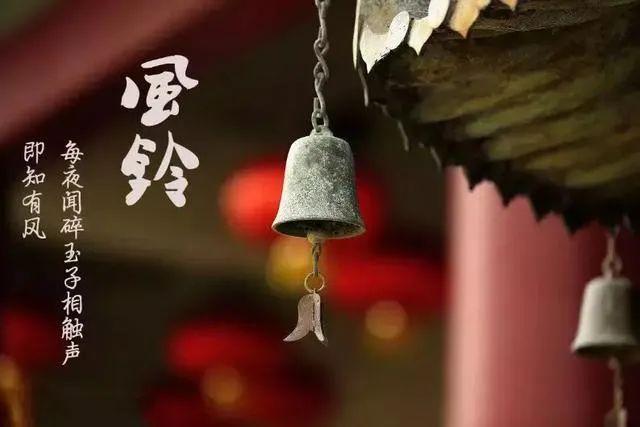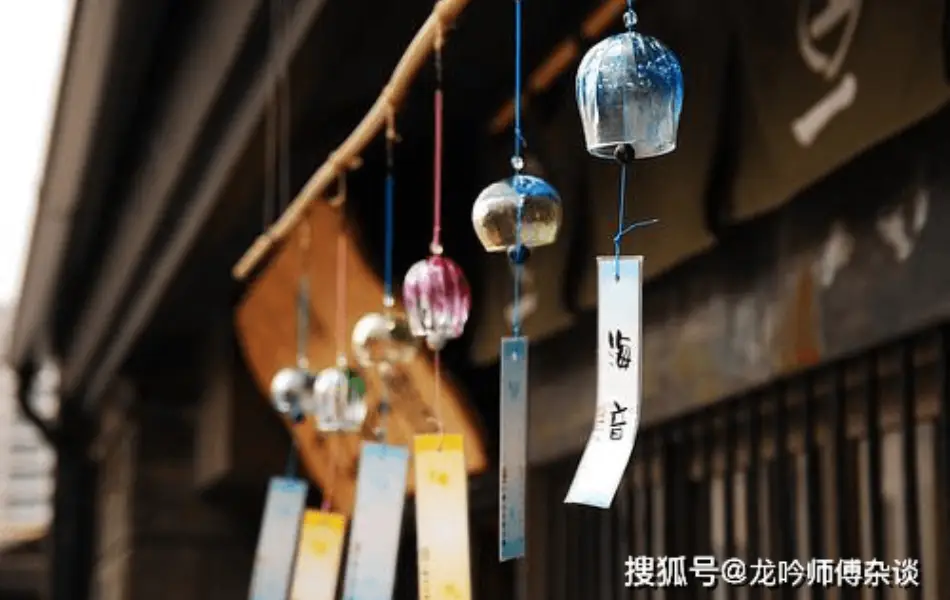Wind chimes are integral tool in the practice of Feng Shui, it operates at the confluence of acoustics, movement, and symbolism, facilitating the manipulation of ‘Qi’ or life force energy within a given space. Crafted from various materials such as metal, bamboo, or crystal, and designed with a specific number of rods, each wind chime possesses a unique resonance and energy influence.
These sonorous instruments not only stimulate beneficial energy flow but also serve as a remedy to counteract negative or stagnant energy. When properly selected and strategically placed, Feng Shui wind chimes can bring about profound shifts in the energy dynamics of a space, contributing to harmony, prosperity, and well-being.
What are wind chimes?
Wind chimes are a type of percussive instrument, comprising suspended tubes, rods, bells, or other resonant objects, that are sounded by the wind. They generate melodious and often soothing tones when the wind causes their suspended components to strike one another or an externally affixed mallet. As such, they represent one of the earliest and simplest forms of wind-powered sound production.
Historically, these devices originated from prehistoric times and were adapted by different cultures globally. The materials used in the construction of wind chimes have varied over time and between cultures, encompassing bone, shell, wood, metal, glass, and ceramics. Each material imbues the chimes with unique acoustic properties, contributing to the rich diversity of tones and sounds they can produce.
The design of a wind chime can be relatively simple, such as a single bell or a small cluster of rods, or complex, featuring an intricate array of suspended objects carefully tuned to specific pitches. This variability in design allows wind chimes to produce a wide spectrum of sounds, from a single, clear note to a complex chord or series of harmonies.
Beyond their role as musical instruments, wind chimes have also held various symbolic and functional roles within cultures. For instance, in Feng Shui, they are used to manipulate the flow of chi, or life energy, within a space. They have also served as a means to ward off evil spirits, as agricultural aids to deter birds, and as meteorological instruments to signal changes in wind direction and intensity.
In contemporary times, wind chimes are commonly used as decorative elements in residential and public outdoor spaces, valued for the visual aesthetics of their movement and the acoustic ambiance they create. They are also used therapeutically for their calming and meditative qualities.
History of wind chimes
Wind chimes have a long and diverse history spanning thousands of years and multiple cultures. The earliest known use of wind chimes dates back to prehistoric times, when they were made from bone, shell, and wood, and were likely used as primitive musical instruments or spiritual objects.
By 2000 BCE, wind chimes had been incorporated into the cultures of both the ancient Chinese and Romans. In China, they were originally used as religious objects and were considered an important part of the practice of feng shui. Wind chimes, particularly those made of bronze, were seen as a symbol of wealth and power, and were often used in rituals. The Chinese also developed the technique of tuning the chimes to specific pitches, and used them in court music.
Meanwhile, the ancient Romans also used wind chimes, or tintinnabulum, as a protective charm in their homes and gardens, where they were hung to ward off evil spirits. The chimes would tinkle in the breeze, producing sounds believed to deter malevolent forces.
In Southeast Asia and the Pacific Islands, wind chimes were traditionally used in fields to scare off birds and other animals that might damage crops. In Japan, glass wind bells known as furin have been produced since the Edo period, and are often used in the summer as a seasonal decoration that provides a cooling effect.
In the modern era, wind chimes are used for various purposes around the world. They are often associated with relaxation and used in meditation practices, and are a common element in garden design, providing not only a visual accent but also a soothing audio landscape. In addition, wind chimes continue to play a role in certain spiritual practices, including feng shui.
Meaning of wind chimes in Feng Shui
Wind chimes hold a profound significance in Feng Shui, the ancient Chinese art of creating harmonious surroundings to augment the flow of Qi (life force or spiritual energy). The strategic use of wind chimes serves as a powerful cure in Feng Shui to counteract negative energy and attract positive energy in living spaces.
Primarily, wind chimes are used as a sound cure in Feng Shui, their melodic tones help to break up stagnant energy and stimulate the flow of chi. The chiming sound not only cultivates a soothing environment, enhancing the energy of serenity, but it also dispels negativity, thereby fostering equilibrium within the dwelling.
The material and the number of rods in a wind chime carry specific connotations in Feng Shui. Metal wind chimes, typically made of brass or aluminium, are effective in the West, Northwest and North sectors of a home or office, according to the bagua, or the Feng Shui energy map. The metallic sound produced by these chimes stimulates the flow of beneficial chi, brings clarity of thought, and encourages intellectual communication.
Wind chimes made of bamboo or wood are preferred in the East, Southeast and South sectors of the dwelling. These chimes are believed to enhance growth, vitality and abundance. The soothing sound produced by wooden chimes stimulates health and fortitude, creating an atmosphere conducive to growth and advancement.
The number of rods a wind chime has also conveys specific Feng Shui energy. A 5-rod wind chime is used to suppress bad luck or bad chi, while a 6-rod wind chime attracts good fortune. A 9-rod wind chime, on the other hand, is employed to promote general well-being, good luck and prosperity.
Wind chimes can also be utilized as a Feng Shui remedy to counteract the “poison arrows” or the harsh energy emanating from sharp angles or corners in a home or office. Strategically placed, the gentle movement and sound of the wind chime serve to deflect and dissipate this potentially harmful energy.
The different types of wind chimes
Wind chimes, embody an integral tool in harmonizing the energies of our environment. They exist in a variety of types, each offering a unique set of resonations and energy influences. A deep understanding of these varieties can greatly assist in making the most suitable choice for your specific Feng Shui requirements.
Firstly, wind chimes differ by the material from which they are crafted. Each material possesses a unique energy, corresponding to one of the Five Elements in Feng Shui – Wood, Fire, Earth, Metal, and Water.
- Metal Wind Chimes: These chimes, traditionally made of brass, bronze, aluminum, or steel, represent the Metal element. They are used primarily to ward off negative energies and stimulate intellectual communication and clarity. Metal wind chimes are particularly beneficial in the West, Northwest, and North sectors of your space.
- Wooden or Bamboo Wind Chimes: These chimes symbolize the Wood element, fostering growth, vitality, and prosperity. They emit a more muted, deeper sound, which is said to foster health and fortitude. Wooden wind chimes are typically beneficial in the East, Southeast, and South areas of your dwelling.
- Glass or Crystal Wind Chimes: Often beautifully colored, these chimes correspond to the Earth element. The refracted light from crystal chimes activates chi and disperses it throughout the area, thus promoting a balanced and positive energy flow.
Secondly, wind chimes can be differentiated by the number of rods they possess, each number embodying a different energy:
- 5-Rod Wind Chimes: The five rods represent the Five Elements and are typically used to suppress bad luck or negative chi. They are particularly effective when placed in the afflicted sectors of a space.
- 6-Rod Wind Chimes: These are considered to bring luck, blessings, and wealth. It is believed they stimulate the beneficial chi to flow freely in the home or workplace.
- 9-Rod Wind Chimes: These are utilized to promote general well-being, good luck, and prosperity. Nine, in Feng Shui, is the number of completion and fulfillment.
Finally, wind chimes differ based on their specific purpose or application:
- Protection Wind Chimes: Some wind chimes are designed with specific symbols or icons known to provide protection. These may include animal symbols such as dragons or tortoises, or other traditional talismans.
- Healing or Therapeutic Wind Chimes: These wind chimes are carefully tuned to specific frequencies or scales that promote relaxation, meditation, or healing.
Understanding these distinct types of wind chimes allows us to tap into their respective energies, bringing balance, serenity, and prosperity into our living spaces.
How to hang wind chimes to create good feng shui
Creating harmonious Feng Shui with wind chimes involves more than just randomly hanging them in your home or office. Their proper placement and careful selection are key to effectively harnessing the energy they are meant to stimulate or regulate. Here are essential principles for hanging wind chimes to create good Feng Shui:
- Identify the suitable area: First, determine the best area to place your wind chime using the bagua, or Feng Shui energy map. The bagua divides any given space into nine sectors, each corresponding to different life circumstances. For instance, the North sector relates to career and life path, the Southeast relates to wealth and abundance, and the Southwest to love and marriage. Select the area you wish to energize and hang your wind chime accordingly.
- Choose the right material: The material of the wind chime should align with the elemental energy of the bagua area where it will be placed. Metal wind chimes (brass, bronze, aluminum, steel) are ideal for West, Northwest, and North sectors. Wood or bamboo chimes work best in the East, Southeast, and South sectors.
- Select the correct number of rods: The number of rods in a wind chime has specific meanings in Feng Shui. A 5-rod wind chime helps to suppress negative energy, a 6-rod chime attracts beneficial chi, and a 9-rod chime promotes overall well-being and good luck. Use this guide to select the most suitable wind chime for your needs.
- Use wind chimes for remedial purposes: Wind chimes can be strategically placed to neutralize the “poison arrows” or harsh energy emanating from sharp corners, overhead beams, staircases, or long hallways. The gentle movement and melodious sounds of the wind chime serve to soften and disperse this potentially harmful energy.
- Maintain your wind chimes: Regular maintenance of wind chimes is crucial in Feng Shui practice. Ensure that your wind chimes are clean and free from dust or cobwebs, as a well-maintained chime encourages positive chi.
- Respect your neighbors: While wind chimes can bring good energy to your home, it’s also important to remember to respect your neighbors. Make sure that your wind chimes are not disturbing others, as this could create negative energy.
LotusBuddhas would like to remind you that while wind chimes are a powerful tool in Feng Shui, their use should also reflect a sense of personal harmony and aesthetic pleasure. The sound and movement of your wind chimes should resonate with you personally, bringing a sense of tranquility, joy, and positive energy to your environment.
How to cleanse and activate the energy of Feng Shui wind chimes
In Feng Shui, maintaining the vitality of objects such as wind chimes is paramount for they play a crucial role in conducting life force energy. Cleansing and activating these instruments ensure they are energetically charged, ready to harmonize your space.
- Cleansing: Begin with physically cleaning your wind chime. Use a soft cloth and a mild solution of water and soap to remove dust and grime. If your chime is made of crystals, you can use a damp cloth for cleaning. A clean wind chime helps to ward off stagnant or negative energy.
- Energy clearing: After physical cleaning, proceed to energy clearing. This can be done in several ways:
- Smudging: This involves burning sage, cedar, or palo santo, and letting the smoke waft over and through the chimes to cleanse their energy.
- Sound clearing: Use a singing bowl or a bell to create a resonating sound near the chimes. The vibration helps to break up stagnant energy.
- Sun/Moon bath: Let your chimes sit in direct sunlight or moonlight. Both the sun and the moon have potent cleansing energies.
- Activation: Once you’ve cleansed your wind chime, the next step is to activate its energy:
- Intention setting: Hold your chime and close your eyes. Visualize bright, positive energy flowing into it, and set a specific intention for what you want the chime to bring into your space (such as harmony, abundance, protection). This personal interaction allows the chime to resonate with your personal chi.
- Blessing: Offer a verbal or silent blessing to the chime. You can speak or think words such as, “May this chime bring peace and prosperity into this home.”
- Placement: After cleansing and activation, hang your wind chime in the chosen spot. Remember to choose the location based on the bagua, or Feng Shui energy map, and the material and number of rods of your chime.
In conclusion, Feng Shui wind chimes are not merely decorative items, but potent instruments that channel the life force to harmonize an individual’s surroundings.
However, you have to approach Feng Shui wind chimes with respect for the traditions they embody, using them with intentionality and mindfulness. As they sway in the breeze, creating a gentle resonance, they serve as a reminder that energy flows all around us, and with the right tools and understanding, we can shape that energy to bring balance, prosperity, and harmony into our lives. LotusBuddhas wish you success!











